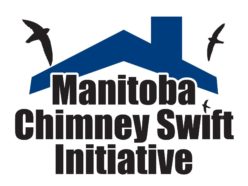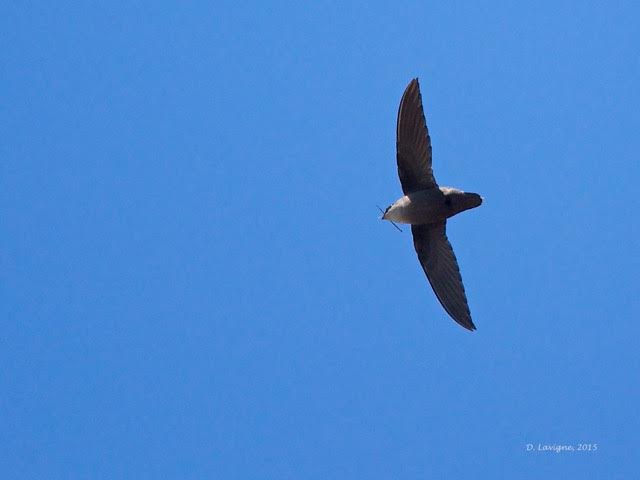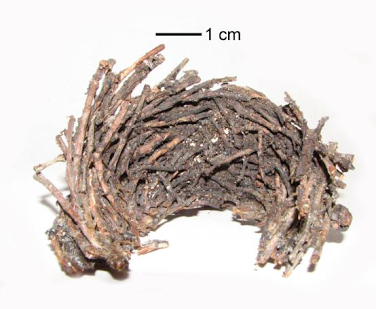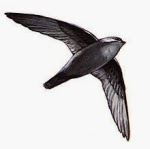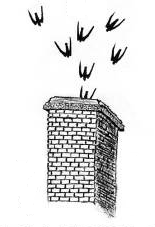News and posts
Update after the National Monitoring Program Evenings
A REMARKABLE PHOTO OF A CHIMNEY SWIFT CARRYING A TWIG
Dave Lavigne took this incredible photograph on June 3, 2015, at approximately 2:20 PM, near St. George’s Anglican Church which is located on North Street, Goderich, ON. THANK YOU Dave for sharing this photo with us all!
-
the body is cigar shaped (perhaps we need to find a new adjective that is more appropriate for the new non-smoking world we live in; zeppelin shaped?).
-
the wings are long. When swifts are soaring with the classic “boomerang-shaped” or “sickle-shaped” wing position, it is easy to see that the wings extend well past the end of the tail. Chimney swifts cannot get up off the ground easily due to their long wings and the configuration of their clinging-adapted feet.
-
the feet are held tightly to the body and are not obvious (giving rise to the Family designation of Apodidae – without feet). Because the hallux or rear toe faces forward to improve clinging onto rough vertical surfaces, chimney swifts cannot perch on branches or wires etc.
-
the tail feathers are very short and bristles project from the ends (one appears shiny white). The stiff bristles are pushed against a vertical surface for extra stability when a swift rests/roosts.
-
the wings are bowed – curving to the rear.
-
the trailing wing margin is intact; later in the season, as moulting occurs, you will notice gaps or discontinuities created by missing feathers.
-
the swift is sooty grey with a lighter throat patch.
UPDATE: NATIONAL ROOST MONITORING PROGRAM (NRMP) SESSION ON MONDAY, JUNE 1, 2015
-
May 24 = NRMP-2: 1 entry/1 exit then 2 roosting entries at Casey’s Inn; 1 exit from Lac Du Bonnet Physiotherapy chimney took place and 1 entry was aborted. The group size seen = 7.
-
May 28 = NRMP-3: 2 entries at Casey’s Inn; no activity at the physiotherapy site. Matt has also been plagued by computer issues; some of his files have been eaten so if anyone has records of his chimney swift or natural history information for Carman, 2010, please email Matt at: ignace_v@hotmail.com
-
Diann and Cam had 3 swifts in Lac Du Bonnet, all around Casey’s Inn; 2 roosted for the night. No entry/exit activity occurred at Lac Du Bonnet physiotherapy, so the dormitory for 1 swift is unknown.
-
Ken, in Dauphin, reports that the head count for the evening was 30+. Good news that the swift survived the weather ordeal of the previous Thursday.
-
David, in La Broquerie, had a quiet night with no aerial activity until 2 swifts quickly approached and entered the Church chimney to roost.
-
In Selkirk, 4 chimneys were monitored and 3 sites were occupied. The total number of roosting swifts = 51 at the Tall Chimney; 0 at the Yellow Chimney; 1 at the Red Brick Chimney; 2 at Merchant’s Hotel.
-
Gordon went to Southport and saw 5 swifts in the air at one time; 2 swifts entered the chimney.
-
Matt in Carman got rained out.
-
Margaret and Millie didn’t: more on their evening below.
-
Ken reported daytime sightings of at least 2 swifts by the big chimney in the old school museum in Melita and several swifts in Souris; evening monitoring was not possible. If anybody can check out these locations for active sites, we would appreciate having these two communities in the database.
-
In Winnipeg, PL and Rob got skunked again at Chancellor’s Hall on the U of M campus.
-
Jane is also hoping for some activity in Assiniboine Park.
-
In St James, Christian saw 1 entry at the Hampton St. Church.
-
Also in St James, Bob and Valerie counted 3 swifts entering for the night at the New Silver Heights Apt.
-
The crew of Adolf, Peter, Kathy, Jake, David had a season record high of ~122 swifts roosting at the Assiniboine School; 0 roosted at King’s; and 1 entered the Carillon chimney.
-
At the Fort Rouge Leisure Centre, Tim and Pierre had 1 entry/exit in Fort Rouge Leisure Centre before 2 swifts came in together to roost.
-
Similarly, Nicole, Cain, and Eli at the Lenore site in Wolseley saw 1 entry/exit prior to a pair of swifts entering for the night.
-
In St. Adolphe, pairs at the NE Club Amical (Rob) and Main St. (Barb) chimneys had an entry/exit cycle before the breeding couple came in for the night. Jacquie and Roberta recorded a pair of entries at Brodeur Bros. while Frank and Lewis had 3 roosting swifts; no exits were made however, so nest building was not underway at these sites (I checked again on Thursday, June 4, over the noon hour and still no daytime activity was seen). Unfortunately, the SE Club Amical chimney was not occupied.
-
The showstopper for NRMP-4 was Millie and Margaret’s Brandon site: 9 entries and 9 exits preceded the 2 roosting entries made by the resident pair of swifts.
There are two important time intervals which may be calculated using “the time of an entry” and “the time of an exit”. I will explain these intervals using some of Millie and Margaret’s data:
-
21:32 entry
-
21:33 exit
-
21:35 entry
-
21:37 exit
-
21:46 entry
-
Rudolf saw 7 swifts over the Northdale Shopping Centre on June 2; both Brazier St. sites had roosting swifts – 1 in at 1010 Brazier; 2 roosted at 1030 Brazier.
-
Ken went out again on Tues. night to his Dauphin roost and saw 32 swifts enter for the night.
-
Matt was waiting patiently for chsw at the Carman Elementary School on June 3 – there were no sightings. Again.
TONIGHT IN SKIES NEAR YOU!
MONDAY JUNE 1, 2015: THE MONITORING SESSION IS 1 1/2 HOURS LONG TONIGHT!
For all of the monitors who are able to watch chimney rims and chimney swifts tonight, for the fourth National Roost Monitoring Program session (NRMP-4), this is a friendly reminder about the change to the length of the observation period.
Please add an extra 1/2 hour of daytime viewing just prior to the roosting hour (calculated as the 1/2 hour before to 1/2 hour after sunset). You will monitor for a total of 1 1/2 hours tonight. The same observation period holds for the alternate NRMP-4 date of June 2 and the last scheduled evening on June 6.
For example, sunset in St. Adolphe tonight is 9:28 PM. The roosting hour = 8:58 to 9:58 PM. By adding an extra 1/2 hour of daytime observations before the roosting hour, we will start monitoring our five chimneys at 8:28 PM.
What is the objective of adding daytime observations? We want to distinguish nest sites vs. roost sites and this is done on the basis of chsw behavior (seen as entry/exit events). Nest sites are used by a breeding pair of swifts to raise their young; in early June, adults make daytime entries/exits as nest building is underway. Roost sites are used by swifts to rest in at night, so we typically see only entries during the roosting hour. We hope to be able to identify active nest sites now so that breeding success may be tracked over the summer…
The last organized evening scheduled for 2015 is Saturday, June 6th. It is cottage season, soccer playoff season, time to watch Chicago whoop Tampa Bay season etc. We know that your lives are busy – please substitute June 5th as a go-to-the-chimney night if June 6 is just not an available target for you.
The MCSI Steering Committee sends a big THANK YOU out to all of the monitors who have been chimney side from the start of the 2015 program and a WELCOME to the new monitors joining us in Fort Rouge and Steinbach tonight. Your efforts are appreciated. Thanks also to our webmaster, Frank, who posts all of your spring migration and site use data on the blog/website.
We have another iffy weather forecast tonight with on/off rain showers and possibly electric storms in Dauphin. Keep safe while you monitor. May your heads stay dry and your swifts be plentiful (and that is aimed specifically for Matt, PL, Rob, Jane, Ian, and possibly other so far “skunked” monitors!).
Happy monitoring, Barb for Christian, Ron, Neil, Lewis, Ken, Nicole, Rob, and Tim.
Update — NRMP Night 3
-
From Ken in Wasagaming comes news that 1 swift was flying around the Riding Mountain National Park Visitor Centre but no entries were observed; the previous night, 8 swifts were overhead.
-
In Selkirk, the monitoring squad had 1 entry in the Merchant’s Hotel; 6 swifts entered the Red Brick Chimney and 8 others disappeared in a “descent” trajectory nearby (another Harry Potter-esque moment!); 32 birds entered the Tall Stack; and 2 swifts roosted in the Yellow Brick Chimney.
-
In La Broquerie, David saw an exit from the church chimney at 8:21 PM = daytime use; it is possible that nest building is underway; a pair roosted for the night.
-
In Portage, Gord saw a larger group size of 9 swifts soaring about; 2 entered the chimney at the Women’s Jail; rain descended before the roosting hour closed.
-
In Selkirk, Ruby & Co. had 50 roosting swifts (an increase of 18 birds from NRMP-2) in the Tall Chimney and 2 in each of the Yellow and Red Brick chimneys (sounds like lyrics to a great song are embedded in those sites).
-
In Carman, it was a frigid night for Matt who saw a couple of swifts on the wing but observed no entries at the Memorial Hall.
-
PL and Rob were skunked again at Chancellor’s Hall on the U of M campus but they reported the first sighting of Common Nighthawks. Thanks for hanging in tough there Pl and Rob – those data points of “0” are still valuable to have!
-
Other nighthawks were seen on May 28 in La Broquerie, the Kenaston area of Winnipeg (afternoon sighting by Matt), Assiniboine School area, Fort Rouge, and near St. Adolphe. Congratulations to Tim who made his first entry of 4 nighthawks on his life list! Interestingly, on May 29, Lewis had one roosting on his backyard railing (Linden Woods) at 1040 AM!
-
Nicole also had no entries at her Fleetwood Apt site but a couple of swifts were on the wing in Wolseley.
-
Tim, in Fort Rouge, saw swifts hawking in the area and 2 roosted at the Leisure Centre.
-
Christian was in the high reward zone – swifts flew in the corridor around Hampton St. and a pair roosted for the night in the church chimney.
-
Bob and Valerie had their pair return to the New Silver Heights Apt.
-
Peter, Kathy, and Adolf recorded ~52 swifts entering the Assiniboine School (approximately the same as for NRMP-2); difficult viewing conditions prevented confirmation of entries into two other sites.
National Roost Monitoring Night 2- Things are Looking Up!
-
Luc, in St Jean Baptiste, had 4 swifts in the church chimney
-
Ken saw 2 in the air near the Riding Mountain National Park (RMNP) Visitor Centre, Wasagaming
-
Rudolf had 4 swifts over the Northdale Shopping Centre, East Kildonan (Winnipeg)
-
Carolyn, in the Hampton St. area, St. James (Winnipeg) on May 21
-
Blaire, St Norbert (Winnipeg), on May 22
-
Margaret and Millie, in Brandon
-
Rudolf who saw a group of “6 swifts tearing around Wellington Crescent and Oak” on May 26
Sunday, May 24 was a glory day – sundrenched and warm (maybe even downright hot at 28 C south of Winnipeg). Here are the early reports
:
-
In Carman, Rhonda saw 2 chsw but did not have entries at the Elementary School (1 had entered on NRMP-1). Matt had 0 sightings while monitoring the Memorial Hall which has been a historical, migratory roost. Disturbingly, Matt has noted unusual migration characteristics this year: no cliff swallows or night hawks have been seen near the bridge yet and few purple martins are in town. Coupled with the low number of chsw, the insectivores seem to be challenged generally this spring. News flash: 1 swift entered Memorial Hall on Monday May 25th!
-
Ken & Jan in Dauphin had a quiet night while a merlin patrolled the area near the chimney. Then, just after sunset, 19 chsw arrived for the night.
-
In St. Adolphe, chsw came in for a few fly-around laps then roosted within 10 min of sunset – we had the same number roosting as for NRMP-1 but had different “loading of sites”: I saw 2 enter Main St.; Kathy and Rob had 2 in the NE Club (the SE Club was occupied Wed.); Jacquie and Frank report a “domestic situation” that may have resulted in 1 in the Church and 1 in Brodeur Bros.; 1 chsw was unaccounted for of the group of 7 seen in town.
-
Gord, in Portage, saw 7 chsw flying about and 2 roosted at the Victoria Church chimney – the first entries noted for 2015.
-
David had 3 arrivals for the night at La Broquerie which also was the first occupancy noted for the season.
-
Rudolf monitored a chimney swift void – none was seen over Northdale Shopping Centre, East Kildonan (Winnipeg).
-
PL and Robert were similarly skunked on the U of Manitoba campus.
-
There was a lot action over in St. James though which was reported by David, Anna, Adolf, and Garth : 1 chsw entered the Carillon; 3 entries were seen at Kings – 1 was early at 8:20 and it is possible that an exit was made; the Assiniboine School was again the show stopper with 73-80 swifts roosting! The challenge is to count clusters of swifts e.g., 25 or 45 in a group, all trying to drop into a chimney in a short period.
-
Elsewhere in St. James, Christian had 1 entry at the Hampton St. Church which was less than the 2 reported for NRMP-1.
-
Bob and Valerie’s count of 2 in the New Silver Heights Apts is holding steady.
-
Tim had 2 swifts roosting in the Fort Rouge Leisure Centre – up 1 from Wed.
-
Also in Fort Rouge, Quinn had 3 entries and 1 exit and a Beresford site, while Ian is waiting for a first arrival at a private home (where a few years ago, his brother came home to find a chsw flying about the basement – it had left the chimney through a gap!)
-
Swifts landed in the Wolseley neighbourhood: Nicole saw 2 swifts enter the Fleetwood Apt chimney and Colin also had 2 enter the Evanson site
Things are looking up…
Temperatures plummeted below average during the day and
-
Tim in Fort Rouge (Winnipeg) had an entry in the Fort Rouge Leisure Centre chimney and ~5 other birds were seen on the wing; Quinn was positioned elsewhere in the neighbourhood and did not see any swifts.
-
David, Adolf, and Kathy in St. James (Winnipeg) saw 2 enter the Carillon and a glorious 55 roosted at Assiniboine School (up from 13 seen by Christian on Monday, May 18)
-
Valerie and Bob, also in St. James, reported 2 in at New Silver Heights Apt
-
Christian, at another St. James site, recorded 2 chimney swifts entering a Hampton St. church chimney
-
In the Wolseley neighbourhood of Winnipeg, 6 swifts were on the wing – Stephan, Meagan, and Colin saw 1 entry; Nicole and Cain saw 0 at another site; Marhsall saw 0 at a third site; unfortunately, a fourth site was found to be capped this spring
-
PL and Rob had 0 sightings at Chancellor’s Hall, U of M campus in Fort Richmond (Winnipeg)
-
Ken and Jan in Dauphin saw their roost numbers increase to 9; one of the swifts had trouble lining itself up on the opening but after several unsuccessful attempts, where it overshot the opening, the swift dropped in = a sign of a migrant who was unfamiliar with the site
-
Diann and Cam in Lac Du Bonnet discovered A NEW SITE where 1 swift entered
-
Gord in Portage noted 4 swifts were in the downtown area but they did not go into the chimney at Red River College – Victoria school.
-
Rhonda and Matt in Carman reported 1 entry at the Elementary School and although one swift was flying about the Memorial Hall, no entries were seen.
-
Frank and Jacquie checked out Otterburne on May 21 and had 5 swifts over Providence College – 1 roosted in the large chimney and 5 roosted in the skinny chimney.
-
In St. Adolphe, 2 swifts entered each of the Main St., Church, and SE Club Amical chimneys (2 other sites were unoccupied) and 2 swifts were unaccounted for.
-
The Selkirk Squad reported 21 roosting swifts in the tall stack (a traditional roost) but no entries at 3 other sites; some monitors did not see any swifts.
-
David in La Broquerie had no sightings of swifts.
A little change…
Hopefully this email finds you without frost, rain, and snow, and with lots of promise for returning chimney swifts. The National Roost Monitoring Program (NRMP) is due to start Wednesday May 20; it continues on May 24 and May 28.
We are looking forward to hearing from you about your swifts!
